WAKING A SLEEPING GIANT - W.V. FootballIf you’re looking for the best place to become a great student-athlete, check out West Virginia’s football program.By Kim Goss Published: Spring 2000 When a promising high school football player is looking for a great college, they first think of the big names. Michigan, Notre Dame, Penn State, and of course all those schools surrounded by orange trees. Yes, these football powerhouses are certainly known for recruiting the best high school athletes, enjoying the lion’s share of victories and appearing in the most prestigious bowl games. But when it comes to getting the most out of an athlete’s talent, it’s tough to fine a better place than West Virginia. Did you know, for example, that 17 athletes currently playing in the NFL have come from West Virginia? That last year, ten athletes entered the draft, and eight will probably make it this year? Head Strength Coach Al Johnson reveals one reason for such remarkable success. “One thing we emphasize, and take a great deal of pride in at West Virginia, is athlete development. Every day we challenge our players to be the best they can be, to exceed their upper limits.” Another reason for their success is the stability of the program, especially among the coaching staff. Head Coach Don Nehlen has been in charge for 20 years, and his coaching staff have been with him an average of 14 years. This consistency has earned him 16 winning seasons, 12 bowl trips, and two perfect regular seasons that lead them to play in the National Championship Game not once, but twice. Nehlen’s accomplishments are especially impressive when you consider that when he took over the program in 1979 it had just suffered its fourth consecutive losing season. “I said on the day I was introduced that West Virginia was a sleeping giant, and I’m proud of my part in seeing that proved true,” says Nehlen. To stay at the top in college football for two decades requires adjusting to the changes in the game, and few have done it as well as Nehlen. “We still subscribe to roughly the same basic football, but our offense looks tremendously different now. My basic philosophy-’You must be able to run to win’-hasn’t changed, but my definition of ‘balance’ is different. It used to be 60 runs and 40 passes, but now it’s about 45-40.” Beyond the X’s and O’s, Nehlen has an exceptional ability to communicate with his players and earn their respect, as evidence by these comments from Consensus All-American Canute Curtis at the 1996 Butkus Awards: “I have to thank Coach Nehlen for making me a man at West Virginia. He and his coaches took a chance on me out of high school, because when I left there, I was just an immature little boy. But they made me the man I am today. I learned a lot of football at West Virginia, but more than that I learned how a man needs to deal with life.” Just as Nehlen’s players don’t forget him, he doesn’t forget them. One way Nehlen shows his appreciation to his former players is through his involvement with the Don Nehlen Open, a golf tournament held the Friday before the spring football game. This year 55 past WVU football lettermen participated, including NFL stars Jeff Hostetler and Rich Braham. If you still need a reason to consider Mountaineer football, realize that at WVU the student body and the community are behind you 100 percent. Johnson says they average about 55,000 fans per game, and that the school has extensive positive support from the media. “What’s neat about playing football here is that we’re on TV eight to ten times a season, whether it be on CBS, ESPN, or a regional broadcast.” You Can Come Home Johnson, along with his assistants Dave Lawson and Mike Barwis, is responsible for three weightrooms and over 400 athletes in 20 sports. He has one son, Adam, with his wife, Jan. A former letterman in football and track who graduated from Glenville State College, Johnson started his career as strength coach when he became a graduate assistant at West Virginia under Dave Van Halanger (now at Florida State). Johnson accepted the head coaching responsibilities at WVU in 1982. “I had a background in powerlifting, and had always been interested in strength and conditioning. But it was Coach Halanger who taught me about motivating athletes, and what it takes to be a Division I strength coach.”After the 1988 season in which WVU took on Notre Dame in a bowl to decide the National Championship, Johnson left the college environment for four years to coach the Baltimore Orioles. “I was one of the first five strength coaches in professional baseball, and I thank God for the other four guys who were ahead of me,” says Johnson. “You talk about barriers! You talk about misconceptions! You’ll have pitchers tell you, ‘Hey, I can’t run the ball to the plate, and batters who’ll say, ‘I’m not going to bench press the ball out of the park.” Then there were the veterans, who had the attitude of, ‘I got here without you, I’m going to stay here without you, and I’m going to be here long after you leave.” Because strength training was not mandatory for the Orioles when he arrived, except for stretching, Johnson had only 14 guys from the 25-man roster willing to work with him during his first year. “With college athletes you have more control over the discipline of the athletes.” Johnson kept at it and earned their trust, and by his last year virtually the entire team was working out. Although there were some younger players who saw the value in conditioning, the greatest influence Johnson had to get players in the weightroom was Cal Ripken, Jr. “The best thing for me going to the Orioles was Cal Ripken Jr. I attribute a lot of my success to Cal Jr., because he was the leader of the team.” Johnson admits that after four years the requirements of being involved with a major league baseball team were getting to him. “People look at it as glitz and glamour. The first year it’s kind of neat, but you’re on the road about 125 days a year and at times you don’t know what day it is-it’s just a crazy, crazy lifestyle. So when the athletic director at WVU asked if I was interested in getting my old job back, I tell you, it was a pretty easy decision.” Johnson came back just in time, because that first year he saw his Mountaineers take on Florida in the game that would decide the National Championship. Johnson also says he was pleased to find that the college baseball players were really starting to get into strength training, which he says was recently sparked considerably by the success of Mark McGwire. “No question there-McGwire’s success has made my job as a college strength coach a lot easier.” Building the Mind Behind the Muscle Having been involved in strength training for almost two decades, Johnson has seen a trend in using a variety of conditioning methods, rather than emphasizing just one type of training such as powerlifting. “From my perspective, most strength coaches are now incorporating multiple training stimulus in their programs. Just about every strength coach is using some type of Olympic lifting movement, some type of plyometrics-although they may not call it plyometrics, preferring the term ‘speed training.’” Over his years of experience Johnson has also seen the effect of Bigger Faster Stronger on the strength coaching profession. “Coaches all over the country are always talking about what they saw in the recent issue of BFS. Our coaches used to cut out the articles and post them on the bulletin board, and it was very motivating for us to read what an athlete in Arizona was doing as opposed to another athlete in Minnesota. I’ve meet Dr. Shepard on numerous occasions and heard him speak, and he’s been ahead of his time as far as getting the word out on strength and conditioning.” As for basic workout design, Johnson’s favorite core lifts for football are the squat, bench press, push press and the power clean (which he prefers to perform from the hang). “Our biggest emphasis over that past seven years has been to develop a lot more hip, lower back, and leg strength-football is played with the lower body.” Has this change in |
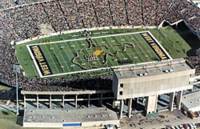 |
|
West Virginia Football Stadium |
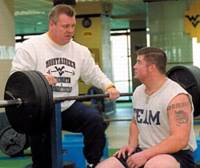 |
|
Head Strength Coach Al Johnson talks with Mountaineer Defensive Tackle Greg Robinette. His impressive 795 lb Squat and 535 lb Bench helped him achieve his powerful 36” no-step vertical jump. |
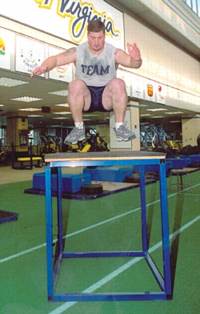 |
|
|
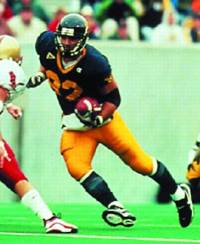 |
|
West Virginia tight end #82 Anthony Becht came to WV as what you would term a ‘project.’ He was undersized, not highly recruited, but had a great work ethic, mental toughness and became an excellent player. |
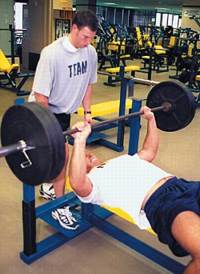 |
|
Anthony doing six reps with 315 lbs on the bench with baseball player Nate Reiser. |
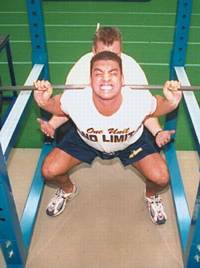 |
|
Anthony Becht working hard on the Squat. Here he is doing 405 lbs. for several reps with Coach Al Johnson spotting from behind. |
 |
|
Greg Hang Cleaning 315 lbs. for reps with Assistant Coach Dave Lawson looking on. His Power Clean max is 375 lbs. |
 |
|
Then there’s a special award, for the best of the best, called the Iron Mountaineer Award. The recipients receive an eight-pound statue carved from coal to acknowledge their achievement. Greg Robinette won this award an unprecedented three times. |
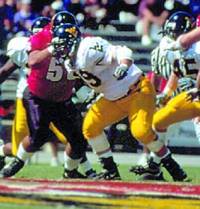 |
|
Greg Robinette #99 powers his way through the offensive line against Maryland. |